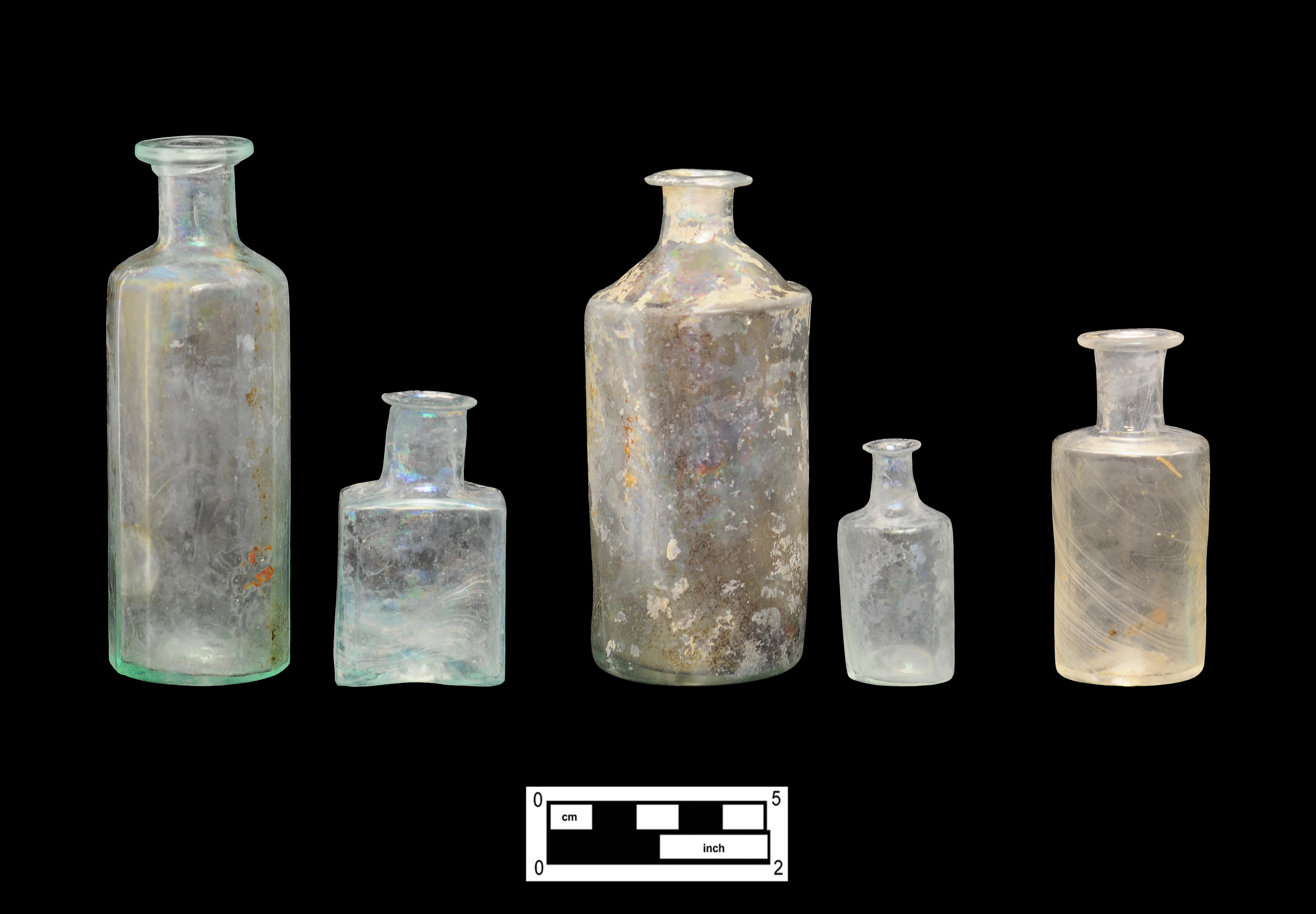
Pontil-Scarred “Utility” Bottles
A small number of pontil-scarred “utility” type bottles were recovered from Feature 5, including two free-blown bottles and three mold-blown bottles. The free-blown aqua bottles are round in cross-section, but are quite crudely made and slightly asymmetrical. Both feature blow-pipe (or open pontil) scars and thinly flared finishes. The larger of the two (G-0975) measures approximately 4.5 inches tall, while the smaller bottle (G-0849) measures a miniscule 2.75 inches in height, with a diameter under one inch.
All of the mold-blown bottles were made in two-piece “hinge” molds, though one (G-0970) is rectangular in cross-section, another (G-0852) is cylindrical, and the third (G-0851) 12-sided. The rectangular aqua bottle features chamfered corners and, like the free-blown examples, a thinly flared finish and blow-pipe scar on its base. This small bottle measures 2.5 inches in height, with base dimensions of 1.5 inches x 1 inch. The 12-sided aqua bottle features a blow-pipe-scarred base, applied “prescription” finish, and measures 5 inches in height. The mold-blown cylindrical bottle is made of colorless lead glass, and thus the bottle is notably heavier than its aqua counterparts. This bottle features thicker walls, a more substantial (though equally crude) flared finish, and a glass-tipped pontil scar. It measures 3.25 inches in height.
Because none of these bottles are marked with any proprietary or product information (they would have originally featured paper labels that have long ago deteriorated), it is difficult to determine what they once held. The aqua bottles were likely used for medicinal products, though the lead glass example may have been a perfume or other form of toiletry bottle. The identity of one of the few embossed bottles from Feature 5 (see “L. W. Glenn” bottle next) could lend support to this idea, though it is possible that the unmarked bottle was imported.
None of these unmarked bottles would have been made any later than the American Civil War and, in fact, their forms and method of manufacture are the same as bottles produced in the early nineteenth century. Despite these observations—and primarily based on the presence of flared finishes, pontil scars, and free-blown examples—the group likely dates from the 1840s into the 1850s, perhaps even a bit earlier.

“DR. DAVIS’S // COMPOUND // SYRUP OF // WILD CHERRY // AND TAR” Bottle
A large portion of an octagonal aqua bottle (G-0963) was also recovered from Feature 5. Though the upper portion of the body and finish are missing, the majority of the embossing is still legible. Spread across five vertical, sunken panels, the embossing reads “DR. DAVIS’S // [CO]MPOUND // [SYRUP] OF // WILD CHERRY // AND TAR.” Unlike the embossed sunken panels, the remaining three panels around the back are flat and flush with the angles of the bottle. The base bears a blow-pipe scar.
Dr. Davis’s Compound Syrup of Wild Cherry and Tar seems to have been first advertised in Philadelphia around 1845, and was offered for “Consumption, Coughs, Colds, Asthma, Bronchitis, &c.” 1 Those afflicted with tuberculosis (historically known as consumption), appear to have been the product’s primary target group, as the compound was billed as a “REMARKABLE CURE OF CONSUMPTION, attended with SPITTING OF BLOOD, HECTIC FEVER, and NIGHT SWEATS, by the use of DR. DAVIS’S COMPOUND SYRUP OF WILD CHERRY AND TAR.” 2 Early advertisements in Philadelphia provide a list of the agents for the sale of the product in the city, and interestingly include G. W. Vaughan at Queen (later Richmond) Street and Shackamaxon Street in East Kensington. 3 Both of 2921 Richmond Street’s first two occupants, the Schwarz (1846–1851) and Staake (1851–1854) families, moved to the address from East Kensington, so it may be that one of these families brought this bottle with them from their former home, or were at the very least quite familiar with and continued to patronize G. W. Vaughan’s business. The archaeological context where the bottle was found and its method of manufacture certainly date to these families’ occupations, though unfortunately, Dr. Davis’ product likely did very little (if anything) for whatever respiratory ailment plagued the family member.
References
- “Dr. Davis’s Compound Syrup of Wild Cherry and Tar” advertisement, Daily Pennsylvanian (Philadelphia), December 16, 1845, page 2, column 6. ↩
- “Remarkable Cure for Consumption” advertisement, Daily Pennsylvanian, December 23, 1845, page 3, column 2. ↩
- “Remarkable Cure for Consumption,” Daily Pennsylvanian, December 23, 1845; “Dr. Davis’s Compound Syrup of Wild Cherry and Tar” advertisement, Public Ledger (Philadelphia), December 12 1845, page 3, column 2. ↩